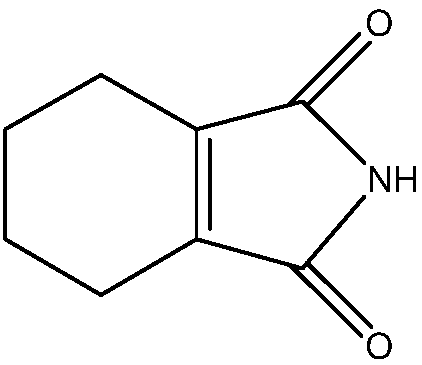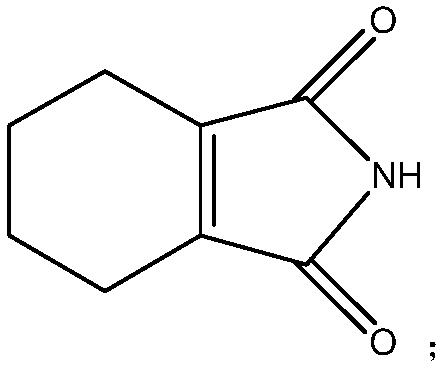Method for synthesizing 1-cyclohexene-1, 2-dicarboximide
A technology of dicarboximide and phthalimide, applied in the field of synthesis of 1-cyclohexene-1,2-dicarboximide, which can solve the problem of low product quality, difficult separation and difficult application For problems in the fields of biology and materials science, achieve high conversion rate, high selectivity, and avoid polymerization side reactions
- Summary
- Abstract
- Description
- Claims
- Application Information
AI Technical Summary
Problems solved by technology
Method used
Image
Examples
example 1
[0036] Add 14.7g (0.1mol) of phthalimide, 500ml of N,N-dimethylformamide and 1g of 60% palladium carbon (5%) on a dry basis in a 1L stainless steel magnetically stirred autoclave, and close the reaction kettle . After the air in the kettle was replaced with nitrogen, stirring was started to raise the temperature.
[0037] When the temperature rises to 90°C, the gauge pressure is 0MPa. At this time, hydrogen gas was introduced, and the temperature in the kettle was ensured to be between 85-95°C. After 15 minutes, the pointer of the pressure gauge was raised, the hydrogen inlet valve was closed, and the heat preservation and stirring were continued for 2.5 hours, and the pressure gauge returned to zero.
[0038] Open the hydrogen inlet valve again, and after 40 minutes, the pointer of the pressure gauge rises, close the hydrogen inlet valve, continue to keep warm and stir for 2 hours, and the pressure gauge returns to zero.
[0039] In this way, whenever the pressure gauge ha...
example 2
[0043] Add 55g (0.37mol) of phthalimide, 700ml of N,N-dimethylformamide and 5.5g of 60% palladium carbon (5%) on a dry basis in a 1L stainless steel magnetically stirred autoclave, and close the reaction kettle . After the air in the kettle was replaced with nitrogen, stirring was started to raise the temperature.
[0044] When the temperature rises to 80°C, the gauge pressure is 0MPa. At this time, hydrogen gas was introduced, and the temperature in the kettle was ensured to be between 75-90°C. After 35 minutes, the pointer of the pressure gauge was raised, the hydrogen inlet valve was closed, and the heat preservation and stirring were continued for 3 hours, and the pressure gauge returned to zero.
[0045] Open the hydrogen inlet valve again, and after 40 minutes, the pointer of the pressure gauge rises, close the hydrogen inlet valve, continue to keep warm and stir for 2 hours, and the pressure gauge returns to zero.
[0046]In this way, whenever the pressure gauge has ...
example 3、4、5
[0050] Except catalyzer, repeat example 2 operation, obtain the result shown in the following table. The catalyst filtered out in Example 2 was only dried (vacuum oven, 100° C., 5 hours), and no new catalyst was added, and was directly used in Examples 3, 4, and 5.
[0051]
[0052] As can be seen from the above table, the catalyst can be recycled and used mechanically. But when it is applied to the third time, the content of the product drops significantly, the melting range of the product is long, and there are many impurities.
PUM
 Login to View More
Login to View More Abstract
Description
Claims
Application Information
 Login to View More
Login to View More - R&D
- Intellectual Property
- Life Sciences
- Materials
- Tech Scout
- Unparalleled Data Quality
- Higher Quality Content
- 60% Fewer Hallucinations
Browse by: Latest US Patents, China's latest patents, Technical Efficacy Thesaurus, Application Domain, Technology Topic, Popular Technical Reports.
© 2025 PatSnap. All rights reserved.Legal|Privacy policy|Modern Slavery Act Transparency Statement|Sitemap|About US| Contact US: help@patsnap.com



